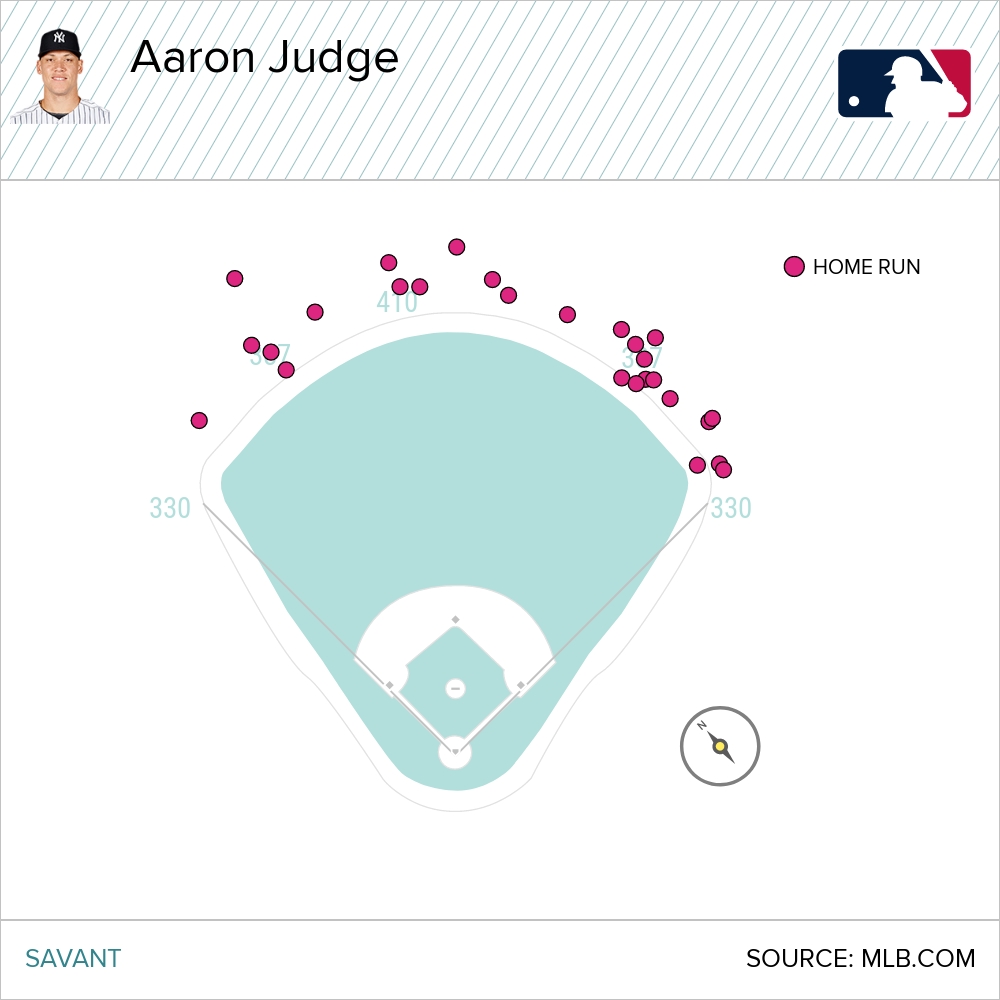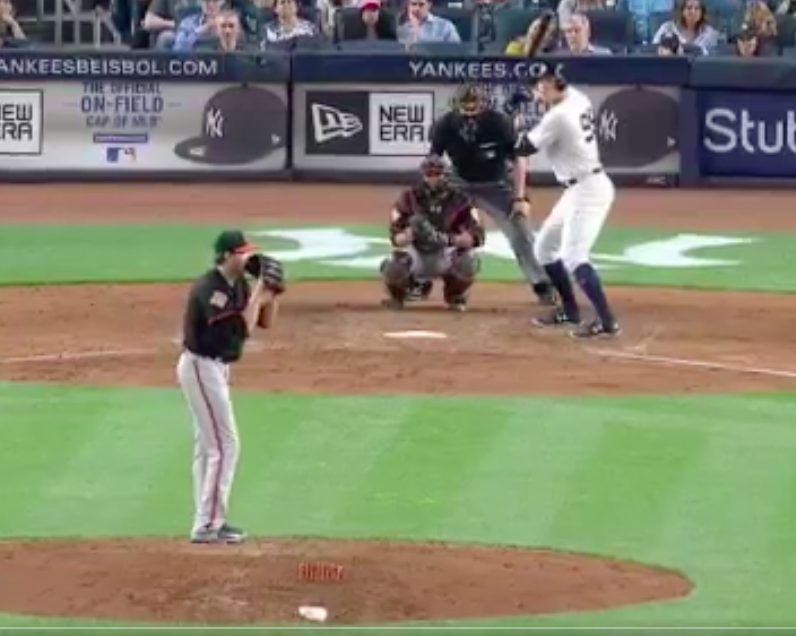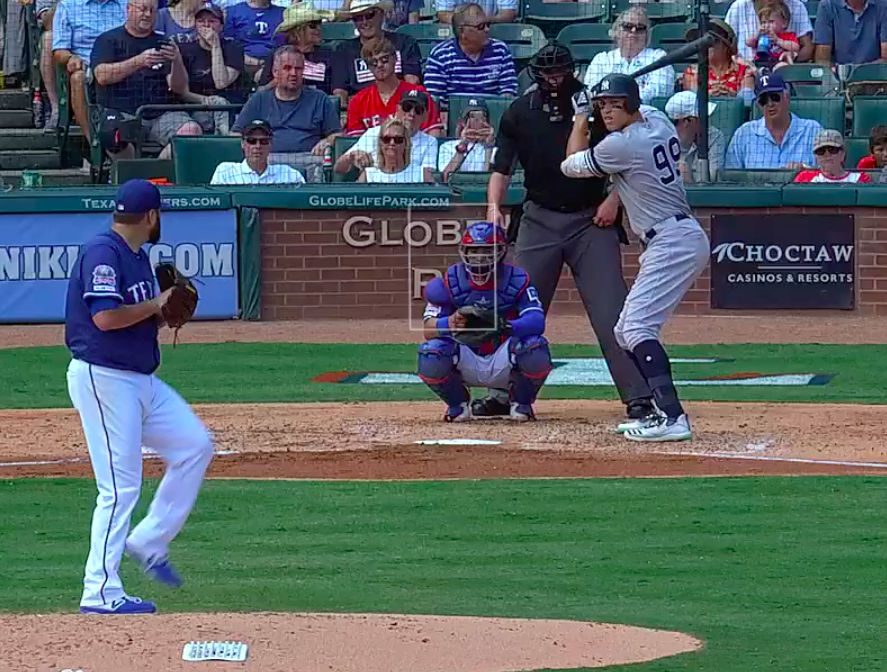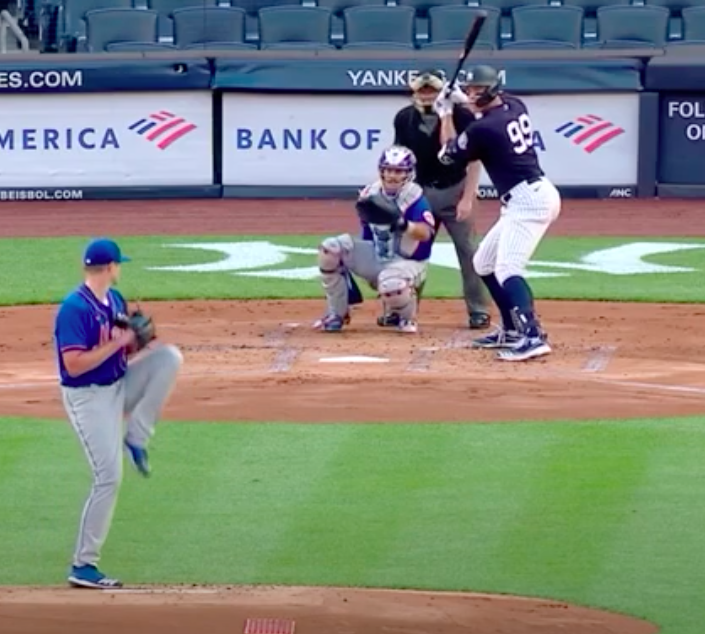Aaron Judge’s 2017 was the stuff of legend. In addition to finishing second in the MVP voting, he was the Rookie of the Year, won a Silver Slugger award, and made the All-Star team. The reason? In 155 games, he hit .284/.422/.627, with 52 HR, 128 runs, 114 RBI, 9 SB, and a 174 wRC+, enabling him to amass 8.3 fWAR. Believe it or not, that’s more WAR than Tony Gwynn ever generated in a single season.
Since then, Judge has been on a similar 155-game pace in terms of WAR due to improved defensive play and baserunning, but his power-hitting hasn’t been the same. His SLG and ISO each dropped about 100 points in 2018. Likewise, prorate his 112 games played from 2018 to 155 games, and Judge hits 37 HR. Do the same for 2019 and he hits 41. Those are impressive totals in their own right, but not quite what he accomplished in 2017. Of course, that could be attributed to injury. Judge missed two months in 2018 due to a fractured bone in his wrist and even longer in 2019 as a result of an oblique strain.
I’ve noticed something, however, in the Yankees few recent exhibition games that lends hope to Judge returning to his torrid home run pace from 2017. Most obviously, Judge has hit three home runs in three games. But I’m more interested in the means than the ends. And with the Yankees’ season kicking off tonight in our nation’s capital, I’ll be watching to see whether Judge will continue utilizing his new approach — and if it will bring him success.
Judge’s Hitting Profile
Preliminarily, it’s worth observing that Judge still has the same raw power that he had three years ago.
| Season | Avg Launch Angle | Avg Exit Velocity | Hard-Hit Rate | Barrel Rate |
|---|---|---|---|---|
| 2017 | 15.6° | 94.9 mph | 53.80% | 25.70% |
| 2018 | 12° | 94.7 mph | 52.60% | 16.20% |
| 2019 | 11.3° | 95.9 mph | 57.10% | 20.20% |
Even though these marks have fluctuated year to year, Judge’s exit velocity, hard-hit rate, and barrel rate are still elite and, in some respects, unparalleled across the league. For example, last year, he had the highest exit velocity, best hard-hit rate, and second-best barrel rate among all qualified hitters.
More to the point, however, is that Judge actually hit the ball harder last year than he did during his prolific 2017 season. His hard-hit rate and exit velocity were both career-bests in 2019. Hitting barrels, however, requires both elevated exit velocities and launch angles. And Judge’s barrel rate in 2019 was lower than in 2017 because he wasn’t putting the ball in the air as often, as evidenced by his batted ball profile:
| Season | GB% | FB% | LD% | Pull% |
|---|---|---|---|---|
| 2017 | 35.2 | 33.1 | 26.3 | 39.1 |
| 2018 | 41.7 | 28.6 | 27.1 | 37.2 |
| 2019 | 41.2 | 26.5 | 30.7 | 37.8 |
| MLB Avg | 45.5 | 22 | 25.5 | 36.6 |
Generally, one must hit fly balls to hit home runs. Pulling a fly ball is the easiest way to hit a home run because ballpark fences are shortest down the line and pull power is much easier to activate than hitting to center or going the opposite way. As per Statcast data, Judge’s ground-ball and line-drive rates have trended up while his fly-ball rate has declined since 2017. Similarly, his pull rate has waned.
Still, his fly-ball and pull rates both remain well above league average. That should be sufficient for home-run hitting, particularly in light of the fact that exit velocity is far more important than launch angle, and Judge’s exit velocity was elite last year. Nonetheless, Judge hasn’t been able to repeat his 2017 home run pace in either of the last two seasons.
There’s something else going on here.
Pulled Fly Balls
Although Judge’s pull and fly ball rates have, independently, remained elevated since 2017, he has had trouble actually combining the two.
| Season | Pulled FB% | Pulled GB% | Oppo FB% |
|---|---|---|---|
| 2017 | 7.7 | 18.6 | 11.8 |
| 2018 | 3.8 | 22.2 | 14.3 |
| 2019 | 2.5 | 23.5 | 12.6 |
To that point, his pulled balls in play have become increasingly concentrated into ground balls rather than fly balls. His pulled fly-ball rate is less than a third of what it once was. That’s not ideal for a power hitter. Likewise, Judge’s share of fly balls to the opposite field has also increased since 2017.
With more pulled ground balls and fly balls hit the opposite way, Judge has deceptively maintained high fly-ball and pull rates. But his suboptimal pulled fly-ball rate in 2019—only six total such hits in 102 games—has depressed his home run totals. Have a look at Judge’s 2019 home run spray chart:

As you can see, it’s not only that the share of his fly balls going to the opposite field has increased. In terms of results, he’s pulling fewer and fewer home runs too. And that’s problematic. Even with the short porch to left in Yankee Stadium, he’ll still play half his games elsewhere. Plus, as Nick Gerli notes, from 2016-18, a righty’s pulled fly ball down the left-field line produced, on average, a 1.786 slugging percentage. If anything, Judge would want to maximize that hit type.
Ultimately, this all begs the question: what mechanically has been driving these changes in Judge’s batted ball profile? Said another way, why is he pulling fewer fly balls?
Open, Closed, and Open Again
Let’s start with 2017. For your viewing pleasure, here’s Judge hitting a laser off Kevin Gausman with an exit velocity of 119.2 mph:
.@TheJudge44 is not fair. pic.twitter.com/AY1dADqryH
— MLB (@MLB) April 29, 2017
At the time, that was the hardest-hit home run of the Statcast era. (Incidentally, I attended that game, but was looking down at my phone and completely missed the home run because it happened so fast.)

More importantly, however, is Judge’s batting stance. Note how open he was. Put differently, his stride is long and his left foot is diagonally out in front of him, which opens up his chest to Gausman.
Opening up one’s batting stance is associated with higher pull rates. When sitting back and open, a hitter can get the bat head out in front of the ball which, in turn, creates the ability to pull the ball across the body. That would explain the copious amount of pulled fly balls Judge hit in 2017.
Fast forward two years and here’s the very last home run Judge hit in 2019:
https://gfycat.com/finemajesticclingfish
Although Judge did pull the ball there, his stance is more germane to our discussion.

Observe how Judge’s feet are now parallel to one another. Where a gap was once visible between his legs, now they are lined up almost completely square to Lance Lynn. You can also see more of the back of his jersey because he’s turned away, as evidenced by the location of his front shoulder.
In a closed stance like this, Judge’s generally going to be later to the ball (because he’s facing away) and, as a result, he’ll reach the ball deeper in the zone. That’s why hitters with closed stances go the opposite way with ease. By the same token, a closed stance also makes it more difficult to be early to the ball and pull it across his body.
In spite of these differences, it seems that Judge has returned, at least in part, to his old batting stance. Here’s the first of his two home runs from the other night in which the Yankees teed off on Corey Oswalt.
Good evening … #AllRise pic.twitter.com/052MggtUuC
— New York Yankees (@Yankees) July 19, 2020
The only videos available of Judge hitting his second home run off Oswalt begin with his leg kick because that’s when the Mets’ broadcast caught it. The same goes for his strange three-out home run off Vince Velasquez the other night, which happened after the Yankees cut to a commercial break. As a result, I won’t be able to show you any useful images of those at-bats from the front. I was, however, able to find a live shot from the stands of the Velasquez home run:
Okay so the #Yankees had already recorded three outs but Joe Girardi told the Phillies to stay out for one more at-bat. That’s why YES Network went to commercial.
Judge then makes them pay and the HR (even after three outs) still counts 🤔 pic.twitter.com/PXwmqbk3oO
— Max Goodman (@MaxTGoodman) July 21, 2020
In the first second of that clip, Judge actually takes a step forward and out toward third base, opening him up to Velasquez. His stride is much longer than in 2019. For a better look, here’s a still from the video above of his first home run off Oswalt.

Once again, Judge’s stride is longer. His front foot no longer blocks his back foot as in 2019, but there’s still no gap between his legs as there was in 2017. Accordingly, I’d peg this to be somewhere between his 2017 and 2019 stances. He’s not as open as 2017, but he’s also not as closed as 2019.
Moreover, with such a long stride, his weight is now placed on his back foot, meaning that he’s begun his load much earlier. He doesn’t have to rock back before swinging forward. This should allow him to shift his weight forward into his swing, catch the ball earlier, and pull it.
I’d also note that Judge has lowered his hands back to where they were in 2017. His hands are much closer to his chin, whereas last season they were next to his helmet. I’ve written about the benefits of lowering one’s hands in connection with Roberto Pérez’s breakout last year:
But Pérez has also lowered his hands. Now, they’re level with his front shoulder instead of his head. As former player and hitting coach Matt Stairs has discussed, the idea behind this swing change is to start lower in order to be quicker to the ball. Instead of beginning with your hands up and then bringing them down to start your swing just to bring them back up again to load, you start low and go straight to the baseball. There’s one fewer superfluous movement, which increases bat speed and shortens up the swing.
Juxtaposing Judge’s final 2019 home run (left) with his home run off Oswalt the other night (right) better illustrates all of these changes, giving me an opportunity to summarize:

Fundamentally, Judge’s stride is longer and his front foot is no longer parallel with his back foot, creating more of an open stance. His weight is now on his back foot, enabling him to shift forward when he swings to catch the ball earlier.
As noted above, he has also quite obviously lowered his hands, which should make him quicker to the ball.
Whether these changes yield success is an open question. With three home runs in just three exhibition games, they do appear to be auspicious. Returning, even only partially, to his batting stance from 2017 hopefully makes Judge quicker in the zone, yielding more pulled fly balls. Besides, who wouldn’t want to see Judge set the league on fire?
Featured Image Adapted By Rick Orengo (@OneFiddyOne on Twitter)
